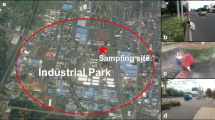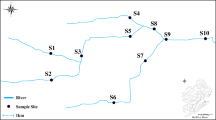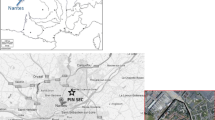Abstract
Stormwater runoff from urban surfaces often contains elevated levels of toxic metals. When discharged directly into water bodies, these pollutants degrade water quality and impact aquatic life and human health. In this study, the composition of impervious surface runoff and associated rainfall was investigated for several storm events at an urban site in Orlando, Florida. Total mercury in runoff consisted of 58% particulate and 42% filtered forms. Concentration comparisons at the start and end of runoff events indicate that about 85% of particulate total mercury and 93% of particulate methylmercury were removed from the surface before runoff ended. Filtered mercury concentrations showed less than 50% reduction of both total and methylmercury from first flush to final flush. Direct comparison between rainfall and runoff at this urban site indicates dry deposition accounted for 22% of total inorganic mercury in runoff.






Similar content being viewed by others
Notes
Use of any trade, product, or firm names in this publication is for descriptive purposes only, and does not imply endorsement by the U.S. Government.
(Same with footnote 1)
(Same with footnote 1)
References
American Society for Testing and Materials (1991). Annual Book of ASTM Standards, Section 11, Water and Environment Technology, Philadelphia, PA.
Brezonik, P. L., & Stadelmann, T. H. (2002). Analysis and predictive models of stormwater runoff volumes, loads, and pollutant concentrations from watersheds in the Twin Cities Metropolitan Area, Minnesota, USA. Water Research, 36, 1743–1757.
Clarke, J. F., Edgerton, E. S., & Martin, B. E. (1997). Dry deposition calculations for the clean air status and trends network. Atmospheric Environment, 31, 3667–3678.
DeWild, J. F., Olund, S. D., Olson, M. L., & Tate, M. T. (2004). Methods for the preparation and analysis of solids and suspended solids for methylmercury. U.S. Geological Survey Water Resources Investigations, Book 5, Chapter 7, Section A.
Dupuis, T., Kreutzberger, W., Kaster, J., & Harris, T. (1985). Effects of highway runoff on receiving waters, V. guidelines for conducting field studies. U.S. Department of Transportation Report No. FHWA/RD-84/066, U.S. Federal Highway Administration.
Fitzgerald, W. F., Engstrom, D. R., Mason, R. P., & Nater, E. A. (1998). The case for atmospheric mercury contamination in remote areas. Environmental Science and Technology, 32, 1–7.
Fulkerson, M. (2006). Atmospheric mercury deposition in an urban environment. Dissertation. University of Central Florida.
Fulkerson, M., & Nnadi, F. N. (2006). Predicting mercury wet deposition in Florida: A simple approach. Atmospheric Environment, 40, 3962–3968.
Gildemeister, A. E. (2001). Urban atmospheric mercury: The impact of local sources on deposition and ambient concentration in Detroit, Michigan. Dissertation. University of Michigan.
Gilmour, C. C., Henry, E. A., & Mitchell, R. (1992). Sulfate stimulation of mercury methylation in freshwater sediments. Environmental Science and Technology, 26, 2281–2287.
Graves, G. A., Wan, Y., & Fike, D. L. (2004). Water quality characteristics of stormwater from major land uses in South Florida. Journal of American Water Resources Association, 40, 1405–1419.
Kobriger, N. P., Meinholz, T. L., Gupta, M. K., & Agnew, R. W. (1981). Constituents of highway runoff – Volume III, Predictive procedure for determining pollution characteristics in highway runoff. U.S. Department of Transportation Report No. FHWA/RD-81/044, U.S. Federal Highway Administration.
Lee, J. H., & Bang, K. W. (2000). Characterization of urban stormwater runoff. Water Research, 34, 1773–1780.
Lewis, M. E., & Brigham, M. E. (2004). National field manual for the collection of water-quality data. U.S. Geological Survey Water Resources Investigations, Book 9, Chapter A5, Section 5.6.4.B.
Makepeace, D. K., Smith, D. W., & Stanley, S. J. (1995). Urban stormwater quality: Summary of contaminant data. Critical Reviews in Environmental Science and Technology, 25, 93–139.
Mendenhall, W., & Sincich, T. (1995). Statistics for engineering and the sciences. New Jersey: Prentice-Hall.
Mosley, L. M., & Peake, B. M. (2001). Partitioning of metals (Fe, Pb, Cu, Zn) in urban run-off from the Kaikorai Valley, Dunedin, New Zealand. New Zealand Journal of Marine Freshwater, 35, 615–624.
Muschack, W. (1990). Pollution of street run-off by traffic and local conditions. Science of the Total Environment, 93, 419–431.
NADP (1997). Quality assurance plan: mercury deposition network. Illinois State Water Survey, Champaign, Illinois, http://nadp.sws.uiuc.edu/lib/qaplans/mdn-qap-1997.pdf/ [accessed 5 March 2005].
NADP (2003). MDN glass sample train collection and deployment – Trace metal clean sample handling. Illinois State Water Survey, Champaign, Illinois, http://nadp.sws.uiuc.edu/lib/manuals/mdnopman.pdf/ [accessed 9 September 2003].
Novotny, V., & Olem, H. (1994). Water quality. prevention, identification, and management of diffuse pollution. New York: Van Nostrand.
Olund, S. D., DeWild, J. F., Olson, M. L., & Tate, M. T. (2004). Methods for the preparation and analysis of solids and suspended solids for total mercury. U.S. Geological Survey Water Resources Investigations, Book 5, Chapter 8, Section A.
Pitt, R., Field, R., Lalor, M., & Brown, M. (1995). Urban stormwater toxic pollutants: Assessment, sources, and treatability. Water Environment Research, 67, 260–275.
Ramasamy, S. (2002). Development of the traffic simulation model for the UCF campus using paramics. Dissertation. University of Central Florida.
Sakata, M., & Marumoto, K. (2004). Dry deposition fluxes and deposition velocities of trace metals in the Tokyo Metropolitan area measured with a water surface sampler. Environmental Science and Technology, 38, 2190–2197.
Sansalone, J. J., & Buchberger, S. G. (1997). Partitioning and first flush of metals in urban roadway stormwater. Journal of Environmental Engineering, 123, 134–143.
Schroeder, W. H., & Munthe, J. (1998). Atmospheric mercury – An overview. Atmospheric Environment, 32, 809–822.
Schueler, T. (1994). The importance of imperviousness. Watershed Protection Techniques, 1, 100–111.
Seigneur, C., Vijayaraghavan, K., Lohman, K., Karamchandani, P., & Scott C. (2004). Global source attribution for mercury deposition in the United States. Environmental Science and Technology, 38, 555–569.
Standard Methods for the Examination of Water and Wastewater (1989). American Public Health Association, Washington, D.C.
USEPA (1983a). Results of the nationwide urban runoff program. PB 84-185552. Washington, D.C.: U.S. Environmental Protection Agency, Water Planning Division.
USEPA (1983b). Methods for the chemical analysis of water and wastes. EPA 600/4-79/020. Washington, D.C.: U.S. Environmental Protection Agency, Office of Research and Development.
USEPA (1992). NPDES stormwater sampling guidance document. EPA 833-B-92-001. Washington, D.C.: U.S. Environmental Protection Agency, Office of Water.
USEPA (1996a). Method 1669. Sampling ambient water for trace metals at EPA water quality criteria. EPA 821-R-96-008. Washington, D.C.: U.S. Environmental Protection Agency.
USEPA (1996b). Method 1631. Mercury in water by oxidation, purge and trap, and cold vapor atomic fluorescence (CVAFS). EPA 821-R-96-012. Washington, D.C.: U.S. Environmental Protection Agency.
USEPA (1997). Method 1630. Methylmercury in water by distillation, aqueous ethylation, purge and trap, and cold vapor atomic fluorescence (CVAFS). Draft method. Washington, D.C.: U.S. Environmental Protection Agency.
USEPA (2005). Clean Air Mercury Rule, U.S. Environmental Protection Agency, Washington, D.C., http://www.epa.gov/air/mercuryrule/ [accessed 17 March 2005].
USGS (2005). Wisconsin District Mercury Laboratory Quality Assurance Manual, U.S. Geological Survey, Middleton, WI, http://infotrek.er.usgs.gov/mercury/ [accessed 12 May 2005].
Vermette, S., Lindberg, S., & Bloom, N. (1995). Field tests for a regional mercury deposition network – Sampling design and preliminary test results. Atmospheric Environment, 29, 1247–1251.
Acknowledgments
Primary funding for this project came from the USGS National Water Quality Assessment (NAWQA) Program and the USGS Toxic Substances Hydrology Program. The assistance of the USGS Wisconsin Water Science Center Mercury Laboratory and David Krabbenhoft for providing laboratory analyses of Hg are greatly appreciated. Thanks also to Mark Olson (USGS) and John DeWild (USGS) for technical support. Also, the assistance of the HAL (Frontier Geosciences, Inc.) for providing MDN data is acknowledged. Special thanks to Marian Berndt (USGS), Mark Brigham (USGS), and Denny Wentz (USGS) for their meticulous review of this work.
Author information
Authors and Affiliations
Corresponding author
Rights and permissions
About this article
Cite this article
Fulkerson, M., Nnadi, F.N. & Chasar, L.S. Characterizing Dry Deposition of Mercury in Urban Runoff. Water Air Soil Pollut 185, 21–32 (2007). https://doi.org/10.1007/s11270-007-9396-y
Received:
Accepted:
Published:
Issue Date:
DOI: https://doi.org/10.1007/s11270-007-9396-y




